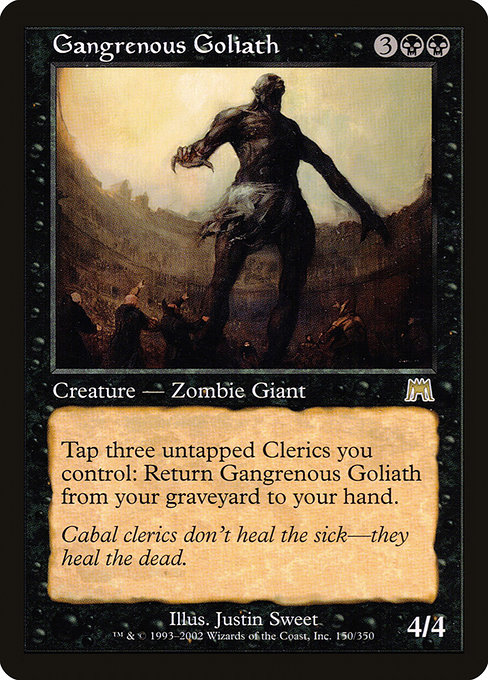
Image courtesy of Scryfall.com
Probability, Persistence, and the Goliath Graveyard: A Look at Gangrenous Goliath
When you reach for a five-mana black behemoth with a thick, old-school flavor, Gangrenous Goliath stands out in the Onslaught era—an era that loved big creatures, graveyards, and a touch of Cabal mischief 🧙♂️🔥. This rare zombie giant clocks in at 5 mana for a 4/4 body, and its real trick is not a flashy combat ability but a graveyard recursion clause: tap three untapped Clerics you control, and this card hops back from the graveyard to your hand. It’s a design that invites deliberate tempo games, where you bankroll card advantage by recycling threats rather than hard-casting them every time. The flavor text — “Cabal clerics don't heal the sick—they heal the dead”—lands with a sly grin, tying the card’s identity to a world where life and death are bargaining chips in the same dark ledger ⚔️🎨.
From a probability perspective, that line of text creates a fun, quantifiable puzzle: how often can you realistically assemble three untapped Clerics to reclaim your Goliath from the grave? The answer isn’t a single number but a spectrum shaped by deck construction, tempo, and how many Clerics you routinely untap on your turns. In a typical Cleric-friendly shell—black-heavy, possibly white-leaning for the cleric density—the likelihood hinges on three factors: how many Clerics you have in the deck, how reliably you can untap them by the time you want to trigger the ability, and how quickly you can refill your graveyard with a recastable beater. If your list leans into Cleric synergy and durable graveyard presence, you’ll see the Goliath pop up in midgame more often than a blind gamble would suggest. A dash of probability theory here, a sprinkle of deck-thinning there, and suddenly what looked like a clunky recursive target becomes a legitimate tempo engine 🧙♂️🎲.
In practical terms, consider a black-heavy build that runs multiple Clerics—think in terms of eight or more Clerics across the deck, with some redundancy in the late game. If you’re drawing through roughly 60 cards, the chance to encounter three untapped Clerics by turn 5 or 6 begins to compound, especially with fetches or tutors that favor your preferred color identity. The math can get intricate fast, but the takeaway is straightforward: Gangrenous Goliath rewards patient setup and punishes hasty overextension in a graveyard-centric plan. When you clinch the three-untapped-Clerics condition, you’ve created a small, reliable engine—your graveyard becomes a hand you can refill with a single well-timed tap. It’s a delightful blend of resilience and risk, perfect for players who relish long-term planning and the delightfully grim humor of Cabal magic 🧠💎.
From a design and archetype perspective, Gangrenous Goliath embodies Onslaught’s penchant for multiplayer-friendly, midrange gravity with a twist. It’s a card that invites players to favor the long game: stabilize the board, stock Cleric threats, and then swing with the Goliath from the graveyard when the moment is right. The art by Justin Sweet captures a moody, undead grandeur that fits the set’s dark, subterranean aesthetic—an image that’s equal parts dread and inevitability. The rarity designation as a rare, paired with a strong graveyard interaction, gives it a place of respect in vintage-style formats where graveyard abuse still has teeth, even if it’s not a modern staple in Standard ⚔️🎨.
Market notes are a nice reminder of how this card sits in the collector’s imagination. In many printings, Gangrenous Goliath has hovered at modest value, with a rough USD price around $0.20 in nonfoil condition and slightly higher for foil copies. It’s the kind of gem that players snag for fun in EDH/Commander circles—where its graveyard recursions feel thematically fitting and mechanically potent in longer games. If you’ve ever tipped your hat to the old-school Cabal vibe or enjoyed a well-timed graveyard reset, this card is a pocket-sized piece of that history 🧙♂️💎.
To those exploring “probability-based triggers” in MTG, Gangrenous Goliath is a delightful case study: a card whose value isn’t in a flash-in-the-pan ability but in the reliability of a recurring condition. The thought experiment becomes a little simulation you run in your head—what’s the probability you’ll have three untapped Clerics on turn 4, turn 5, or turn 6, given your draw odds, deck composition, and untap phases? The more you lean into Clerics and graveyard synergy, the more those probabilities converge toward a playable rhythm, where the Goliath’s second life comes not by burn or brute force but by a patient, probability-informed plan 🧙♂️🎲.
Product spotlight
While we mull over probability and long-game strategy, a little convenience can help keep your testing and play sessions sharp. If you’re looking to organize your deck-building and card-drafting notes with style, consider the Neon Card Holder MagSafe Phone Case—an eye-catching addition to your gaming setup. It’s a practical accessory that keeps you organized during long sessions, and it pairs nicely with the kind of collector’s mindset that enjoys digging into classic cards like Gangrenous Goliath. Check it out here:
Neon Card Holder MagSafe Phone Case for iPhone 13 / Galaxy S21/S22
More from our network
- https://transparent-paper.shop/blog/post/mastering-testing-and-qa-for-digital-creators/
- https://blog.digital-vault.xyz/blog/post/framing-quicken-card-frames-and-perspectives-in-mtg/
- https://blog.rusty-articles.xyz/blog/post/predicting-traumatic-visions-standard-rotation-outcomes/
- https://crypto-acolytes.xyz/blog/post/halo-wars-2-vs-age-of-empires-iv-which-rts-reigns-supreme/
- https://transparent-paper.shop/blog/post/suns-neighbors-hot-giant-at-27-kpc-with-anomalous-color/